A geisha (芸者), also known as a geiko (芸子/芸妓) or geigi (芸妓), is an artist and lady-in-waiting in Japan, who devotes her life to the refined artistry of traditional Japanese arts for companionship and entertainment, for a very wealthy clientele.
She cultivates artistic refinement in various fields such as kimono dressing, classical music, dance, socializing and conversation, and games... The word "geisha" can be interpreted as "person of arts" or "woman who excels in the craft of art".
Geishas were numerous in the 18th and 19th centuries. They still exist in contemporary Japan, although their numbers are steadily decreasing: estimated at 17,000 in the 1980s, there are only about 200 nowadays, mainly in Kyōto in the Gion district.
However, thanks to better communication about geisha activities, especially through television and the Internet, the number of geisha (maiko) apprentices has recently increased significantly.
The age-old institution of geisha has a close and complex relationship with the phenomenon of prostitution - between the idealization of their role and activities, and historical and social realities. It is certain, however, that the granting of sexual favors by the geisha to her client was never understood as systematic or self-evident.
Geisha Vocabulary
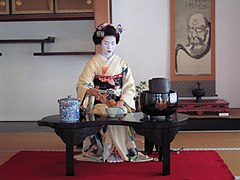
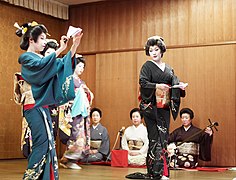
The word geisha is made up of two kanji meaning "art" (芸, gei) and "person" or "practitioner" (者, sha); a geisha is therefore literally a "person who practices the arts" (the word "artist" can also be used, although the translation is not perfectly accurate). The terms geiko (芸子) or geigi (芸妓) are also used.
In the Kyōto dialect, geishas are referred to as geiko (芸妓) and their apprentices maiko (舞妓). In other parts of Japan, mainly in Tōkyō and the rest of Kantō, the word geisha, and the terms hangyoku (半玉) or oshakusan (御酌) are preferred to refer to young girls in apprenticeship.
Geisha belong to the "world of flowers and willows" (花柳界, karyūkai). According to geisha Mineko Iwasaki, a geisha should have the delicacy of a flower and the strength and flexibility of a willow6.
Geishas who specialized in dancing (buyō) or playing a wind or percussion instrument, who were prettier, were called tachikata (立方, "standing person"), those who specialized in singing or playing a stringed instrument jikata (地方, "sitting person"), the latter being considered as accompanists to the former.
Geisha History
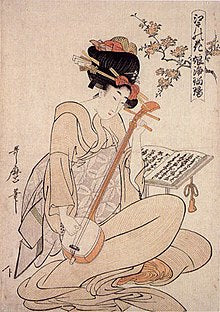
The opening of teahouses (お茶屋, ochaya) in the pleasure districts in 1712 marks the beginning of the geisha profession. Geishas are the result of the evolution of the taikomochi (太鼓持) or hōkan (幇間), Japan's equivalent of medieval jesters in Europe. Thus, the first geishas were men, whose job was primarily to entertain, through song and music, the patrons of teahouses.
At the beginning of their integration into geisha, in the 1750s, women were called onna geisha (女芸者, literally: woman geisha), or geiko (芸妓) in Kyōto. They quickly outnumbered the men, who took the name otoko geisha (男芸者, male geisha) to differentiate themselves from the women. From 1800 on, all geisha were women.
In 1779, the Japanese government formalized the geisha profession and established a registration office (検番, kenban), which was intended to register geisha and enforce the law. The law stated that only licensed prostitutes could have sex with their clients, not geisha.
In 1842, the Tenpō reform outlawed prostitution and closed the pleasure districts, but they reopened in 1851. In 1886, in order to maintain control over the activities of geisha, the government set an official tariff for their activities.
Until the beginning of the 20th century, geisha were considered to be at the forefront of fashion, so much so that with the westernization of Japan in the 1920s and 1930s, geisha who dressed and danced in western style, known as dansu geisha, appeared. But many of them opposed this modernization and posed as guardians of the Japanese tradition, which is still the case today.
In 1944, during World War II, the government closed the pleasure districts and sent the geisha to work in factories to support the war effort. On October 25, 1945, the pleasure districts reopened.
The total prohibition of prostitution in 19578 permanently distinguished geisha from prostitutes. At the same time, new laws were passed to protect the geisha from the public. At the same time, new laws on child labor and compulsory schooling prohibited girls from becoming maiko before the age of fifteen.
In 1965, the Kyōto dentō gigei shinkō zaidan (京都伝統伎芸振興財団, literally "Kyōto Traditional Arts and Music Development Foundation") counted 65 maiko in Kyōto, a number that later dropped to 28 in 1975, before rising and stabilizing at an average of 60 maiko in the 1990s.
In 1993, the Japanese government decided to ban official appointments at ryōtei (traditional high-end restaurants where geisha perform) for its members, and was followed in this decision by the world of finance and industry.
In recent years, there has been a newfound enthusiasm for the geisha profession in Japan, with the first time in April 2008 that there were more than 100 maiko (101 to be exact) in the five hanamachi in Kyōto.
It would seem that this craze is due in particular to the growing amount of information available on this profession: books, television reports and documentaries, but also blogs and personal websites of maiko or geisha.
Geishas of Kyōto
Kyōto is traditionally the city of geishas; it is in this city that the first geishas appeared1. Nowadays, this is the city where they are most numerous.
Geisha Appearance
Dress
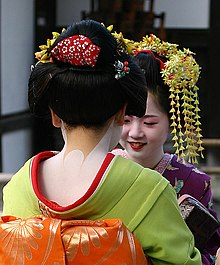
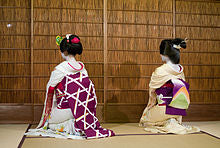
The geisha's garment is a silk kimono with a low back, nicknamed obebe in the Kyōto dialect. The colors of the kimono are chosen to match the color of the geisha. The colors of the kimono are chosen according to the season, but also according to the age of the wearer: young women wear bright colors while geishas over thirty choose more discreet colors.
The kimono is more or less thick depending on the season: the summer kimono, ro, is made of simple silk gauze; the autumn kimono or hitoe is made of unlined silk. Finally, the winter kimono, awase, is lined with crepe.
The kimono is tied in the back with a wide silk belt, called an obi (帯 or おび). This obi is tied differently depending on the age of the geisha: mature women wear it in a "drum knot" (太鼓結び, taiko musubi), but maiko wear it "in drag" (だらり帯, darari obi), with a knot that goes all the way up to the shoulder blades, with the end of the obi trailing almost on the floor.
Such a knot requires an obi several meters long. This knot in the back distinguishes geisha from oiran and other prostitutes, who tied their obi in the front so that they could take it off and put it back on several times during an evening.
Putting on a kimono and tying an obi is a complex operation, especially since kimonos are all the same length regardless of the wearer's size, it is usually necessary to fold the kimono fabric under the obi, except for a very tall geisha. This is why geisha often use the services of a professional "dresser ".
Kimonos are made and painted by hand, which makes them very expensive: between 5,000 and 6,000 euros for a good kimono.
Apart from "ordinary" kimonos, geishas wear for important ceremonies a kimono belonging to their okiya, kurotomesode type, black with five kamon (coats of arms) of the okiya.
As undergarments, geishas wear a koshimaki or "hip cover", a simple strip of thin fabric wrapped around the hips, followed by a jumpsuit. The jumpsuit must match the colors of the kimono, as it appears in two places: at the ankles when the geisha raises her kimono to walk, and at the collar. This collar is traditionally sewn every morning to the suit chosen by the geisha, then unsewn in the evening to be washed. It is red - a color associated with childhood - for the maiko, and white for the confirmed geisha.
Geishas wear tabi socks and wooden sandals (geta) on their feet.
Makeup
Very often the make-up that we associate with geishas is in fact that of maiko. The distinction between the two lies in the wearing of lipstick. Geishas have fully tinted lips. For maiko, during their first year of practice, only the lower lip is dyed to signify that she is new and inexperienced.
The face is entirely covered with white (oshiroi), over a layer of oil called bintsuke-abura. The makeup is applied with a bamboo brush and the excess is dabbed off with a sponge. In the past, this makeup contained lead, so many former geisha suffered from illness and skin problems.
Nowadays, it is made of rice powder. The back of the neck is also covered with white makeup, revealing part of the geisha's skin. The cheeks, eyes and lips are made up with pink and red.
The eyebrows and the outline of the eyes are traced with a stick of paulownia charcoal, or with kohl. The mouth can be entirely tinted with red, but many maiko only make up their lower lip, so as to look sulky.
Makeup is a delicate process, and maiko often get help from their okāsan or a makeup artist when they first start out; later, they must learn to do their makeup themselves. As their career progresses, they decrease the amount of makeup; geisha over the age of thirty hardly wear any makeup at all, except on special occasions.
Hairstyle
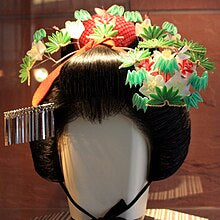
Geisha hairstyles are traditional Japanese buns. They are made at a specialized hairdresser's and have to last one week. In order not to flatten their hairstyle, geisha must sleep on a "neck rest", the takamakura.
Because the buns require a lot of pulling on the hair at the top of the head, many former geisha have a bald spot. This tends to disappear nowadays, partly because maiko start later than before, and partly because some geisha use wigs.
The typical hairstyle of maiko is called "split peach" (momoware or wareshimomo); it is a bun divided in two and in the middle of which appears a silk fabric : formerly red then white once the virginity of the geisha is lost. Today, this color changes when the maiko becomes a geiko. Older geisha wear other types of buns such as marumage. The buns are decorated with combs, as well as hairpins called kanzashi.
Lifestyle and career
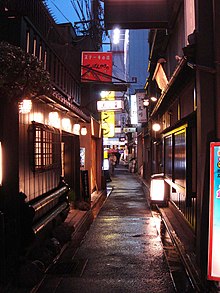
Geishas live in secluded neighborhoods called hanamachi (花街), which means "flower city." The most famous hanamachi in Kyōto are Gion (祇園) and Ponto-chō (先斗町).
They are always attached to a geisha house, an okiya (置屋), although they do not always live there. Okiya are women's houses where very few men are allowed to enter.
The structure of an okiya is similar to a family structure, where the boss is called okāsan, "mother," and the older geisha are considered older sisters to the younger ones. The okiya, to whom the future geisha were usually sold, received most of their wages until their debt was paid in full.
These future geishas saw their debt accumulate as they had to pay for their meals, their education, their clothes, what they broke, and even the price of the okiya's purchase of their person.
An okiya is passed on by succession. One of the geisha in the house is referred to as the "heiress" (atotori): this may be either a natural daughter of the okāsan or a talented geisha adopted by the house. As an heiress, her earnings merge with those of her okiya, and she is expected to become the next okāsan.
Geisha today have a choice of two lifestyles: either they live in an okiya, which provides them with housing and kimonos but receives a portion of their earnings in exchange, or they are independent (jimae): they live in their own housing, and must finance their own clothing and equipment, but they retain almost all of their earnings.
However, they remain attached to the okiya, which serves as their "appointment agency" and receives a small commission in exchange. Whether or not they are independent, they are not allowed to work for the okiya.
Whether they are independent or not, the life of geisha is shared with the whole hanamachi: on each important occasion (beginning and end of apprenticeship, mizuage etc.), a geisha goes around her hanamachi and announces the news to the owners of the teahouses by offering them food or gifts. Usually a ceremony is also held in the geisha's usual teahouse.
Geisha often form real "lines". Indeed, each young girl wishing to become a geisha must find a "big sister" (oneesan), herself a geisha and older than her, who teaches her the trade, takes her to her appointments, and in return receives a percentage of her "little sister's" earnings during the apprenticeship.
The "big sister" and the "little sister" bond in a ceremony called san san ku do, in which they drink three sips from three bowls of sake. This ceremony is also a key moment in traditional Japanese marriage, symbolizing the creation of a bond between two people.
The "little sister" chooses at this moment a geisha name, on the advice of her oneesan. She usually takes a name whose root is the same as that of her oneesan: thus, the little sister of a geisha named Ichiume could take the name of Ichigiku.
A geisha, in order to increase her earnings or to become independent, needs a protector, called a danna, a rich man who gives her various gifts, which does not exempt him from paying the geisha's services at the normal rate. The geisha and her danna are bound in a ceremony similar to the san san ku do.
In the past, the notion of a danna implied that the geisha had sexual relations with her protector, although this was never officially stated ; the danna was often chosen not by the geisha herself, but by the okiya, according to his wealth and prestige.
It is possible that a geisha had more or less ongoing relationships with men she met, but these relationships were usually discreet, as the reputation of an okiya would suffer if its geisha behaved badly. Geishas were expected to be celibate, and those who married gave up their profession.
Geishas who end their careers hold a farewell ceremony, hiki-iwai (引き祝い), in which they offer boiled rice to their oneesan and okāsan.
Formation
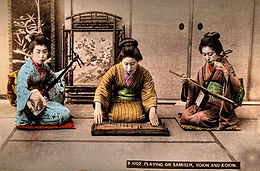
Geishas were traditionally trained from early childhood. Young girls were sold by poor families to the okiya, who were responsible for raising them and ensuring their education.
During their childhood, they worked as maids and then as assistants in the geisha houses to contribute to their training but also to ensure the repayment of the debt incurred for the often high cost of their education and the purchase of their person.
In particular, the youngest girl in the okiya had the task of guarding the entrance and greeting the geisha returning from their appointments. This is a traditional form of training in Japan that continues to this day, in which the student lives in the home of the master, helping him, watching him practice, assisting him and performing household chores. This training often lasts several years.
They began practicing a wide range of arts at an early age. Japanese tradition dictates that children who practice the arts begin "on the sixth day of the sixth month of their sixth year," but sometimes future geishas began earlier, that is, at the right age (three years and three days).
Geisha training included the practice of several musical instruments: the shamisen, a three-stringed instrument typical of geisha, but also the Japanese flute and various traditional drums: the tsutsumi, which was held on the shoulder, the okawa on the thighs, and finally the taiko, the largest, which the geisha placed next to her and struck with a stick.
It should be noted that shamisen tunes were not usually written on sheet music, and geisha learned them by ear.They also study chanoyu (tea ceremony), ikebana (flower arrangement), poetry and Japanese literature.
Traditional dance (buyō) is studied by all geisha to achieve a graceful bearing and elegant gait, but only the most beautiful and talented geisha are encouraged to specialize in this art.
For their apprenticeship, they go through a more or less long period (at least one year) during which they follow and observe their "big sister". They do not have a client, but attend parties in the evening and go to school during the day.
This period, which lasts a few months nowadays, is called minarai (見習い), which means "learning by observation". Very young girls are then called shikomiko (仕込妓), literally "apprentice geisha".
By watching and assisting their elders, they learn the kitsuke (wearing of the kimono), the art of conversation, various games (e.g. the game of who will drink the most, with a customer), and the art of entertaining their customers.
Once they became geisha apprentices, i.e. maiko, they accompanied geishas to tea houses, receptions and banquets. During this period, their oneesan was responsible for passing on her own experience as a geisha, in exchange for a percentage of her "little sister's" earnings.
This training method still persists today but is shortened, as most geisha become geisha in their late teens.
A geisha's training officially ends at the so-called "collar change" (erikae) ceremony, where she replaces her red maiko collar with the white collar of the confirmed geisha.
Traditionally, the maiko was auctioned off when she was deemed worthy of becoming a full-fledged geisha. In the Edo period, their virginity was sold to the highest bidder around the age of 14. By the 1950s, the practice was still alive but the auction did not begin until the maiko turned 18.
Their virginity was priceless and often reached such high sums that only big industrialists could afford them. Their prestige reflects on their firm. The name of danna is given to these rich characters who do not buy only the first night (mizuage) but a whole set of nights sometimes extending over more than a year.
Often married, they buy the admiration of their peers and do not always have sexual relations with the maiko.Today, geisha no longer enter geisha houses as children. Becoming a geisha is now an entirely voluntary act, often done at seventeen or eighteen.
The apprenticeship is still long and difficult; however, as geisha are increasingly difficult to recruit, apprentices are often pampered by their elders, which contrasts with the time when their work was voluntarily difficult, even exhausting, to ensure their obedience.
Geisha Profession
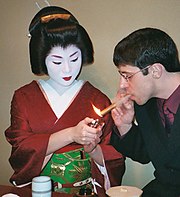
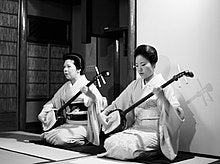
Geisha are not prostitutes, but rather hostesses or refined ladies-in-waiting. Although in the past it was possible and almost systematic to buy their virginity (an event called "mizuage"), they did not necessarily have sexual relations with their clients, or even with the man who had paid a lot of money to buy their virginity. It is however on this level that their name remained in the appellation "geisha balls".
Zashiki
The main job of geisha is to participate in banquets called zashiki. These are usually held in ochaya or traditional restaurants (料亭, ryōtei), but they can also be held in private salons or private homes.
Geisha's role is to entertain their clients; depending on the client and the circumstances, this may be by dancing and playing traditional tunes, or simply by chatting and playing various board games.
There is a distinction between geishas who specialize in dancing and those who do not: the former are nicknamed tachikata (立方, "standing person") or odoriko ("dancer"), while the latter are called jikata (地方, "sitting person") because they sit down to play and sing while others dance.
Zashiki are not open to just any customers. You have to know geisha asobi, the art of entertaining in the company of geisha, and also be a solvent customer.
Indeed, the zashiki are paid on invoice, after the banquet, by the customers to the restaurant, which pays the fees of the geisha to the kenban, which is in charge of distributing the money among the geisha who participated.
If the customers are slow to pay, or do not pay at all, the restaurant must pay the geisha fees itself; this is why many restaurants or ochaya are only open to regulars or to people recommended by their regulars.
Geisha fees are poetically called o-hana (お花) or hanadai (花代), "flower money." They are proportional to the time the geisha spends at the zashiki. A maiko receives only half a hanadai, while a senior geisha receives one.
Performances
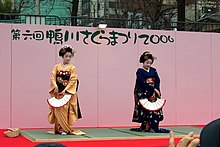
Geisha dancers perform at dance festivals. The most famous festivals in Kyōto are the Kamogawa Odori ("Kamo River Dance") in Ponto-chô, and the Miyako Odori ("Capital Dance") in Gion.
Miyako Odori began at the Kyōto World's Fair in 18716. The Kamogawa Odori began in 1872, and since then has been held annually in May and October; it was not interrupted until 1945, when the okiya were closed during World War II. The Kamogawa Odori is a festival of geishas and geisha.
During these festivals, geishas give performances of traditional dance, but also of kabuki theater, especially for the Kamogawa Odori.
Geishas were not paid for their performances at the festivals. On the contrary, they often spend a lot of money to finance them, and sometimes even go into debt.
This is because for an odoriko (dancing geisha) to participate in a festival is an important mark of prestige. For this reason, geisha who participate in dance festivals are not beginners, they are often at least thirty years old.
Geishas of Tōkyō
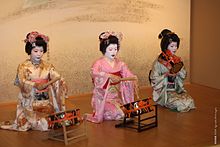
Tōkyō is the second most important city in terms of the number of geisha. The capital of Japan also has its hanamachi, the most famous of which are Shinbashi (新橋), Asakusa (浅草), Mukōjima (向島), Kagurazaka (神楽坂) and Akasaka (赤坂). Akasaka is the most expensive and renowned hanamachi in Tōkyō; it is home, as in Kyōto, to an annual dance festival called Azuma Odori.
In Tōkyō, the term associated with geisha is gyoku ("jewel") rather than hana ("flower"). Their fees are nicknamed "jewel money" (玉代, gyokudai); similarly, apprentice geisha in Tōkyō are called hangyoku (半玉), which means "half jewel" because, as in Kyōto, they receive only half the fee of a confirmed geisha, thus half a gyokudai.
Young girls in Tōkyō generally do not decide to become geisha until they are eighteen, whereas in Kyōto they start at seventeen (child labor laws prohibit starting earlier). Moreover, the apprenticeship period is very short, and hangyoku usually only remain so for a few months to a year and a half.
Unlike in Kyōto, it is common for geisha in Tōkyō to live outside their hanamachi. They are attached to an okiya as required by law, but this okiya serves only as an agency for appointments, and as a dressing room where they store their kimonos.
Geishas in small towns
Provincial geisha are sometimes nicknamed chihō (地方, literally "province"). They are mainly found in tourist or resort areas.
Foreign Geisha
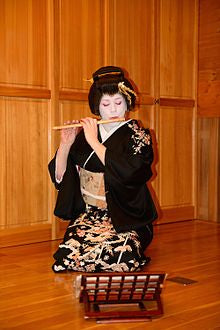
In 1975 and 1976, Liza Dalby, an American anthropologist, closely followed geishas in their activity in Kyōto, to the point of participating in them as well, although she did not have the proper training nor was she part of an okiya.
In 1983 she published Geisha based on her dissertation research work, which was adapted for television in 1986 as American Geisha. She was a consultant for the film Memories of the Geisha. She was a consultant for the film Memoirs of a Geisha released in 2005.
In December 2007, the Asakusa district of Tokyo saw the debut of Sayuki, the first Western geisha in Japanese history. Sayuki, whose real name is Fiona Graham, is an Australian anthropologist who became a geisha as a result of a university project.
However, as of June 2011, Sayuki is no longer a member of the official Asakusa Geisha Association, but nevertheless continues to perform banquets in Tokyo. According to a geisha member of the association, she refused to take the lessons normally required, becoming hysterical when denied the right to practice in front of clients due to lack of training.
According to Peter MacIntosh, a documentary filmmaker who has studied the geisha world for 18 years, Fiona Graham does not act like a geisha.
Prostitution and onsen geisha
Originally, at the beginning of the 18th century, geishas were men, artists by trade, accompanying oiran (high ranking courtesans) in their social evenings, in order to assist them in the quality of their artistic performances.
At the same time, odoriko, very young dancers, appeared as precursors of the genre. Within a generation, the role of geisha was taken over by women, combining both roles, and has evolved to the present day.
Geishas and prostitutes of all ranks were thus historically familiar with the same neighborhoods, although geishas were free to move around, unlike oiran and other lower-ranking prostitutes, who were literally captives of the yûkaku, institutionalized and regulated prostitution areas since the beginning of the 17th century.
Within the karyûkai, "the world of flowers and willows", a term that encompasses both the numerous geisha districts called hanamachi and the yûkaku, which are in contrast unique in each city, the geishas and the oiran of the yûkaku rubbed shoulders.
In fact, the yûkaku were jointly considered as hanamachi, whereas the reverse is not true. The yûkaku of Shimabara in Kyoto survived for a small generation as a hanamachi after the closure of the yûkaku in the 1950s, and finally disappeared as a hanamachi in the 1970s.
In the 19th century, a teahouse could offer, in addition to the use of its geishas for a zashiki, the nightly services of a prostitute, also attached to the house. In times of crisis, it was not uncommon to see geishas of lower class become prostitutes.
However, this was not without consequences, and often the geisha could not hope to regain an honorable position after having openly given in to prostitution.
The Western imagery of the geisha, which is often erroneous, is due to several factors that contributed to the misunderstanding of the two professions mentioned above.
On the one hand, geisha are often depicted in the West with all the exuberant and provocative paraphernalia of the oiran, especially the crossed combs in the hair and the brightly colored kimonos.
In fact, after a period of isolation of just over two centuries, the moment when Japan opened its borders to foreigners (Bakumatsu) coincided with the moment when the oiran still enjoyed a certain aura, while the geisha had reached the height of their glory, taking over the influential role in fashion occupied by high-ranking courtesans a century earlier.
Thus, the ostentatious luxury of the oiran as well as the subtle refinement of the geisha were able to dazzle Western minds with the unattainable complexity and mystery of a Japanese feminine ideal, at a crucial moment in its evolution when the roles of oiran and geisha were still in the making and less clearly defined than later.
The misunderstanding between these two professions, mainly in the West, is also explained by the particular relationship that geishas have with their patron. Like Western artists, geishas use patronage to support the expensive needs of their hairstyles and kimonos.
A patronage which is expressed by exorbitant tips given by their most faithful customers. If none of them benefit from a particular favor, it is different for the geisha who chooses to have a regular patron, called danna.
He had to provide for all her needs, by giving her expensive costumes, buying most of the tickets for her shows if she was a dancer, providing her with housing and an allowance to cover the cost of her hair, as well as those of her dresser and clothes.
If being a danna was the most expensive investment, it brought the bearer of this status social importance and prestige among her family. The geisha, in exchange, gives him all her attention, privileges him in the choice of his zashiki and offered, formerly, to him alone her sexual favors.
Geisha in Japanese spa towns or onsen, places of relaxation where the atmosphere is generally lighter than in the cities, were often more sexually solicited, especially for the game of the "little river", where the dancers progressively lifted their kimono as if to cross a deeper and deeper river. They had thus less good reputation.
Nowadays, this practice has disappeared. With the opening of Japan to the rest of the world in the 19th century, Westerners in Japan discovered these women and were sometimes abused by prostitutes dressed as geishas, especially in onsen. The term onsen geisha is thus used as a euphemism in Japanese to designate these prostitutes pretending to be geishas.
The second significant historical period of foreign presence was the post-war period (World War II), which confirmed the sexualized image of geisha by the number of prostitutes who sold their services pretending to be geisha without being geisha to American soldiers.


